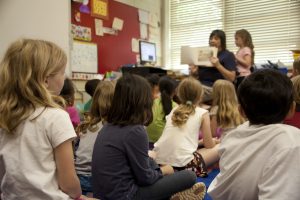
October 11, 2023, by Rupert Knight
A collaborative approach to research-informed teaching
In this post, Rupert Knight offers examples of school-level collaborative inquiry as a teacher-driven form of research-informed practice.
A broad and inclusive view of educational research
A few years ago, in an early blog in this series, I considered ways that teachers might engage with research evidence. Back then, I made the case for teaching as a research-informed profession, but also discussed the limitations of a narrow view of research seen only as ‘What Works’ guidance and highlighted some alternative, school-led approaches.
So, five years on, where are we with engagement with educational research? Certainly, What Works has gone from strength to strength. For example, the toolkit metaphor is now used not only by the Education Endowment Foundation (EEF) but also by Evidence Based Education, while the quest for distilling research into generalisable ‘techniques’ is prominent in popular ‘evidence-informed’ teacher guides offering ‘direct access to the best techniques’ or ‘a set of techniques…used by schools throughout the world’. The very prevalance now of the term ‘evidence’, as opposed to ‘research’, is in part a legacy of the long-standing DfE ambition to emulate the methodologies and apparent certainties of evidence-based medicine.
The top-down application of universal principles – increasingly focused on cognitive science and its applications for memorising content – also underpins DfE claims of a ‘golden thread’ of evidence informing its Core Content Framework, Early Career Framework and National Professional Qualifications. This evidence is underwritten by the (DfE-funded) EEF, which itself produces much of the evidence that is increasingly prized. All of this can feel like a closed system in which evidence for teaching is synonymous only with large-scale studies generating principles translated for teachers by mediators such as Research Schools, a growing range of ‘hubs’ and other, sometimes commercial, organisations.
A decade ago, however, the British Education Research Association, in its influential BERA / RSA publication, which positioned teaching as a research-informed profession, took a broad and inclusive view of what constitutes research. Alongside large-scale studies carried out by researchers, its definition of education research explicitly included:
‘The kind of enquiry-based learning and reflective professional practice that many school and college leaders and teachers will be familiar with in their own practices.’ (p.11)
Perhaps it is time, once again, to reassert the value of this sort of practice-led, ‘bottom-up’ inquiry to complement the generalities of What Works. By way of illustration, I have recently participated in two informal projects with small groups of teachers which take quite a different approach to engaging with knowledge and research.
Two examples of local collaborative inquiry
1. A primary oracy interest group

Making a connection with my own interests in oracy, a group of six primary teachers from a local MAT expressed an interest in developing this aspect of their practice. The teachers came from different schools within the trust and had varying levels of experience, from ECT to school leadership, and teaching roles ranging from Reception to Year 6. We met regularly, twice a term, throughout the school year and participants took turns to host at their schools. The first meeting explored our current understanding of oracy and potential areas of interest and development, including some collaborative discussion around how this might work in one another’s classrooms.
Thereafter, somewhat organically, a pattern emerged. Most meetings began with us observing a short episode of oracy-related teaching in the host’s school and then deconstructing what we’d seen, considering what the important principles and possible adaptations might be. Being observed can be daunting, but a sense of trust developed as we got to know one another. The teaching episode was followed by each participant sharing recent experiences from their own classrooms which had drawn on the previous meeting’s focus. In a second phase, I offered some brief input, relating insights from wider theory and research to the group’s next emerging area of interest (e.g. how to design peer discussion tasks to promote exploratory talk). Based on this, we spent time considering how these principles might be adapted for the group’s different contexts, with a view also to priming an episode of teaching to observe next time. Between sessions, relevant resources and readings were shared online.
2. A secondary mathematics lesson study group

Over recent years, a number of local secondary teachers have expressed an interest in investigating mixed-attainment mathematics teaching in Key Stage Three and have participated in an informal group convened by a teacher educator colleague. The group, badged as a local ‘community’ has a wide membership of teachers and university staff, its own online space for readings, resources and video lesson examples and centres on a loose lesson study approach.
Lesson studies at teachers’ schools involved a three-part process. First, we heard from the hosting teacher and discussed the rationale behind what we were about to see. Then we observed a full lesson, each of us focusing closely on, and noting, designated pupils’ learning experiences. Finally, following the lesson, there was a detailed, step-by-step analysis of what went on, with an emphasis on the pupils’ perspectives. As well as pedagogical, organisational and subject matter considerations, this analysis often gave rise to discussions about bigger questions around issues such as social justice and inclusion, which emerged from the central inquiry focus. For some attendees, such experiences were a direct source of teaching ideas; for some, access to an informal evidence-base beyond their own school; for others, perhaps a glimpse of an alternative approach that may ultimately affirm their decision not to teach in this way in their particular context.
Superficially different but fundamentally similar
These two examples from different phases and with very different areas of focus may initially seem unalike, but they share a number of important features:
-
A shared ‘inquiry’ focus, exploring an aspect of participants’ everyday practice
-
The development of trust through cultivating an ongoing relationship over a period of time
-
The consideration of everyday practice (in these cases, partly through observation) as a stimulus for wider thinking
-
Reference to a wider evidence-base to help illuminate and analyse practice and to suggest approaches worthy of local-level investigation
-
Connections between teachers outside their everyday circle of colleagues, with the opportunity to visit some of their schools
-
An attempt to understand others’ contexts and to co-create and share knowledge across diverse settings
-
An emphasis on professional judgment and adaptations for different contexts
-
The presence of an external participant, able to offer a slightly different perspective from the rest of the group.
Putting the pieces together

One way of thinking about this sort of professional development which involves learning across different sites and among teachers with different workplaces, experiences and areas of expertise is the idea of ‘boundary crossing’. Akkerman and Bakker identify four processes often at play in these situations. Using them helps us to understand how these groups worked together to use and co-construct evidence.
-
Identification involves a sharper realisation of how one’s own habitual practice differs from that of others but also how different approaches may co-exist. Teachers in both groups came to understand how accepted practices in their classrooms and schools related to others. For example, in the secondary mathematics case, much discussion centred on the contextual differences between schools and how this would shape adaptions to the approach. Sometimes this was reassuring and sometimes unsettling.
-
Coordination is about finding common ground and ways of working together. It is about the way that apparent boundaries can be navigated, crossed and made fluid. In the oracy group, for example, a teacher from Year 6 saw for the first time how many of the same principles for peer discussion could be established at the other end of the primary age range, through observation in a Reception classroom.
-
Reflection occurs as participants see their practice from a fresh perspective, in terms of both making their own assumptions more visible and seeing their work through the eyes of others. The mathematics group explored principles and practices that challenged some commonly-held views about ability and led to debate about the aims education. Whether or not these views were accepted by participants, they encouraged new ways of thinking about the rationale behind their own educational decisions.
-
Transformation of practice ultimately leads to developing new ways of working, sometimes prompted by uncomfortable confrontations between ideas, but often sustained by ongoing collaboration between participants. The oracy group meetings encouraged some teachers to allow more space for valuing children’s voices through peer discussion activities. The leap of faith involved was supported by having a safe space to hear other’s experiences and see examples in action.
The external perspective, or the ‘boundary broker’
Finally, you may have noticed that an additional common factor in both examples was the involvement of a teacher educator. Crucially, their role was not to direct, but to facilitate and offer an alternative perspective. Interestingly, some forms of lesson study (as one form of collaboration) make much of the presence of such an ‘outsider’. According to the Lesson Study Research Group at Columbia University, this participant might serve three functions:
-
providing a different perspective when reacting to the group’s work
-
providing information about wider content, ideas, or reforms
-
sharing, or connecting with, the work of other groups
In the two examples described in this blog, the teacher educator played a role broadly corresponding to these three points: they asked provocative questions which challenged assumptions; they made connections to wider sources of evidence and theory and – through their long-standing local connections to schools – they acted as the facilitator initiating the networking opportunity. In many forms of teacher inquiry, therefore, this outside perspective may be very valuable. While these attributes are not unique to teacher educators, they may be ideally placed for this role, with their daily work across and between the boundaries of schools and sometimes universities.
Reconciling ‘top-down’ and ‘bottom-up’ approaches to evidence
So, let’s remember, alongside the large-scale studies and broad-brush principles, that context is also key. As Dylan Wiliam argues in his critique of research in education, the relevant question is usually not ‘What works?’ but ‘Under what conditions does this work?’ Rather than generating a formula to apply, top-down principles can offer a stimulus for bottom-up collaborative inquiry and a way of making sense of the specific. If you are inspired to inquire into an aspect of practice – however informally – and to co-construct evidence and knowledge collaboratively, these questions might be a useful starting point:
-
What problem or issue is worthy of exploration and why?
-
Who might be part of a community that extends beyond your immediate colleagues?
-
What sort of practice-based activity might be your starting point?
-
Which wider sources of evidence might you bring to bear on the issue?
-
When and where might you meet?
-
Who could offer a knowledgeable, external and alternative perspective?
No comments yet, fill out a comment to be the first

Leave a Reply